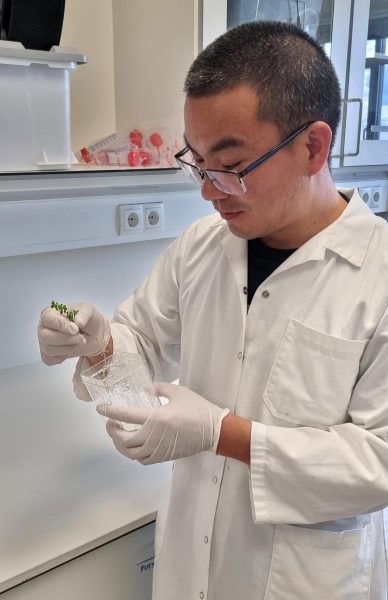The researchers found that zinc has an incredibly huge effect on legumes that fix nitrogen, information which could aid in highly developing agriculture based on legumes.
The challenge to agricultural sustainability comes from climate change, drought, and increasing temperatures, among other abiotic stresses. Quite unexpectedly, a study has now identified the role of zinc in the plant response to abiotic stress. Not only has this clarified the complex mechanisms of plant growth, but it has also opened up new paths to enhance crop resilience, particularly for legume-based farming.Read Also : Improving Data Accuracy: The Influence Of Real-Time Phone Number Verification In Lead Generation Operations
Discovery of Zinc’s Role in Nitrogen Fixation

It’s been well-documented for quite some time that zinc is an element required in nitrogen fixation for legumes. Researchers recently hypothesized that this, coupled with a better understanding of a transcriptional regulator called Fixation Under Nitrate, could pave the way to change the face of legume production: more productive crops and less reliance on synthetic fertilizers. They wanted to clarify how zinc and FUN operate in controlling nitrogen fixation to enhance the bioavailability of nitrogen to crops and ultimately uphold yields and sustainability in farming.
These legume crops establish symbiosis with rhizobia bacteria that fixate atmospheric nitrogen into root nodules. Such nodules, however, are prone to a number of environmental stresses such as temperature fluctuations, drought, flooding, salinity in the soil, and high amounts of nitrogen in the soil.
Breakthrough in Plant Micronutrient Sensing
A team of researchers at Aarhus University, in collaboration with the Polytechnic University of Madrid and the European Synchrotron Radiation Facility in France, found legumes that make use of zinc as a secondary signal to combine environmental factors and control the efficiency of nitrogen fixation. In a study reported in Nature, they found FUN to be a new type of zinc sensor that decodes the zinc signatures in the nodules and controls nitrogen fixation.
“It truly is amazing to find that zinc acts as a second messenger in plants. It is an essential micronutrient, yet has been excluded from the list of known second messengers. Screening of more than 150 000 plants finally revealed a sensor for zinc, the protein FUN, which illuminated this previously unknown aspect of plant physiology,” says first author, Assistant Professor Jieshun Lin.
Deciphering the Activity of the FUN Protein
This research shows FUN is a transcription factor controlling nodule breakdown in response to high soil nitrogen concentrations. “FUN is regulated by a unique mechanism that monitors cellular zinc levels directly. We show that FUN is inactivated by zinc into large filament structures and released into the active form when zinc levels are low,” said Professor Kasper Røjkjær Andersen.
From the farming perspective, continued nitrogen fixation is beneficial since nitrogen will be available to the legume and subsequent crops utilizing residual nitrogen after legumes have been harvested. Therein lays basis for further research in more intelligent management of farming systems, reduction of N fertilizer use, and minimizing impacts on the environment.Also Read : Diagnosis And Management Of Lobular Carcinoma In Situ (LCIS)
Agricultural Efficiency and Sustainability Enhancement

The results of this research are huge. Learn how zinc and FUN wok in nitrogen fixation allows researchers, in turn, to develop ways of optimizing the process in legume crops. This could enhance nitrogen delivery through improved crop yields besides independence from synthetic fertilizers, which is costly in environmental and economic terms.
Researchers are now studying how zinc signals are generated and further decoded by FUN. They want to apply this very discovery immediately in legume crops such as faba bean, soybean, and cowpea.
Potential to Influence World Agriculture
The discovery of the role of zinc in nitrogen fixation can be revolutionary in farming across the world. Soybeans, peas, and lentils all belong to the legume class of crops. They are staple crops in large areas of the world and provide both proteins and nutrients in the human diet. Optimizing nitrogen fixation in these crops will increase their productivity and strengthen them against environmental changes to ensure that food security exists. In particular, this would be useful where soil quality is poor or synthetic fertilizers are unavailable, thus enabling farmers to have more sustainable farming practices.
Environmental Benefits and Sustainability
A decreased reliance on inorganic fertilizers will not only decrease the production cost for farmers but also significantly lower environmental pollution. As it has been aforementioned, an oversized use of nitrogen fertilizers results in run-offs into the aquatic system and consequently promotes eutrophication, harmful algal bloom conditions cutting off oxygen to aquatic life and being toxic by themselves. This research, therefore, advocates also for environmentally friendly farming: more natural nitrogen fixation in legumes allows better water quality and biodiversity. The findings contribute to the broader goals of sustainable agriculture and also link up with global efforts against climate change by mitigating GHG emissions.
Application to Other Crop Systems
Though directed at legumes, general principles and mechanisms that are going to be unraveled would find an application in other crop systems. Knowing how zinc and its related transcription factors impact plant responses to environmental stressors can benefit breeding programs in crops of great diversity. It may help in developing varieties that are more resilient to drought, high temperature, and high soil salinity. Thus, agricultural innovation would increase. The basic nature of this research will promote collaboration between plant science, biotechnology, and agronomy, encouraging a holistic approach to the improvement of crops.
Future Research Directions
Although the mechanisms underlying zinc-mediated nitrogen fixation have been identified, this is but the tip of the iceberg in this journey. Future research is predicted to go down to the molecular pathways and genetic controls involved in this process. In Secretary terms, scientists look forward to identifying additional transcription factors and signaling molecules that interact with zinc and FUN for an integrative explanation of plant nutrient sensing and response. Advanced techniques, involving gene editing via the CRISPR system and, more so, transcriptomics, will be required to unravel such complex networks. To that end, collaborative projects between different international research institutions will be important in translating these scientific insights into working agricultural solutions.
Field Trials and Challenges in Real-World Implementation
Translation from in-vitro experiments in the lab to real-world agricultural applications has its challenges. Field trials will have to be conducted in order to ascertain the efficacy of zinc-enhanced nitrogen fixation against the backdrop of varying environmental conditions. Factors that researchers should use to calibrate crop performance are the local soil type, the climatic variability, and pressures from pests. The preparation of affordable and usable zinc-based treatments will be another milestone if this is to be translated into general practice. Then there will also be indispensable activities of extension services and farmer education in knowledge sharing and best practices for the benefits of this work to spread on to not only the smallholder farmers but also the large-scale agricultural business operations.
Conclusion and Future Directions
The identification of the role of Zn in nitrogen fixation, its regulation by the FUN protein, and other studies in this line have contributed immensely to agricultural science. This definitely is going to open up future opportunities for engineering more resiliently strong food legumes capable of surviving a wide array of environmental stresses. This work could improve knowledge on plant micronutrient sensing and responses to develop more sustainable and efficient agricultural practices.
Such zinc signaling pathways will be the focus of future research, together with the refinement of the application of these findings to legume crops more broadly. The ultimate goal should be to create farming systems that are highly productive yet at the same time in an environmentally sustainable way, reducing reliance on synthetic inputs and mitigating the impacts of climate change on agriculture.

